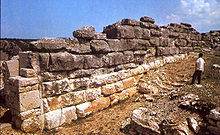 Cyclopean walls of ancient Daorson. | |
 | |
| Location | Ošanići, Stolac, Bosnia and Herzegovina |
|---|---|
| Region | Illyria, Dalmatia |
| Type | Megalithic settlement |
| History | |
| Periods | Classical, Hellenistic, Roman |
| Cultures | Illyrian, Roman |
| Site notes | |
| Ownership | Public |
| Official name | Archaeological area - the Hellenistic city of Daorson in Ošanići near Stolac |
| Type | Category 0 cultural property |
| Criteria | A, B, C iii.iv.v.vi., D i.iv., F i.iii., G iv., H i., I i.ii.iii. |
| Designated | 21 January 2003 |
| Part of | Stolac, natural and architectural ensemble |
| Reference no. | 605 |
| Decision no. | 01-275/02 |
| Listed | List of National Monuments of Bosnia and Herzegovina |
Daorson (Ancient Greek: Δαορσών) was the capital of the Illyrian tribe of the Daorsi (Ancient Greek Δαόριζοι, Δαούρσιοι; Latin Daorsei).[1] The Daorsi lived in the valley of the Neretva River between 300 BC and 50 BC. They came very early into contact with Greek traders acquiring many facies of Greek civilization, and the town acquired a certain degree of Hellenization.[2][3][4][5][6] After the peace treaty with Rome in 168/167 BC, the Daorsi minted their own coins.[7]
The ruins of Daorson is located at Ošanići, near Stolac, Bosnia and Herzegovina.[8][9][10][11]
- ^ Henry A. Ormerod, Piracy in the Ancient World, JHU Press, 1924, p. 184.
- ^ The Art treasures of Bosnia and Herzegovina by Đuro Basler, Mirza Filipović, Sulejman Balić, 1987, page 28, "Only to the south of there, in the River Neretva basin, had the influence of Hellenism taken root, principally among the Illyrian Daorsi who occupied..."
- ^ Grčki utjecaj na istočnoj obali Jadrana: zbornik radova sa znanstvenog skupa održanog 24. do 26. rujna 1998. godine u Splitu by Nenad Cambi,ISBN 9531631549,2002,page 432,"and the 3rd century BC when some of the indigenous tribes were fully hellenized..."
- ^ Institute of Archaeology bulletin by University of London. Institute of Archaeology - 1978, page 21.
- ^ Dalmatia: research in the Roman province 1970–2001: papers in honour of J. J. Wilkes by David Davison, Vincent L. Gaffney, Emilio Marin, 2006, page 21, "completely Hellenised town."
- ^ Stipčević 1977, p. 110: "In many ways they imitated the urban Greek life style, and some scholars refer to this Ošanić gradina as a “completely Hellenized town" ( Z . Marić ), which obviously is an exaggeration, though one having some justification. When speaking about central Dalmatia, one cannot quote any similar case of Hellenization."
- ^ Lippert & Matzinger 2021, p. 105.
- ^ "Regional Programme on Cultural and Natural Heritage in South East Europe". Culture and Cultural Heritage. Retrieved 21 September 2018.
- ^ "Ljubljana Process: rehabilitating our common heritage". Culture and Cultural Heritage. Retrieved 21 September 2018.
- ^ Hazim Begagić. "CHAPTER 2 – HERITAGE POLICY IN BiH AND BENEFITS FROM THE LJUBLJANA PROCESS - Heritage for development in South-East Europe". Council of Europe Publishing. Retrieved 21 September 2018.
- ^ Šašel Kos & Kos 2013: "Ošanići"
